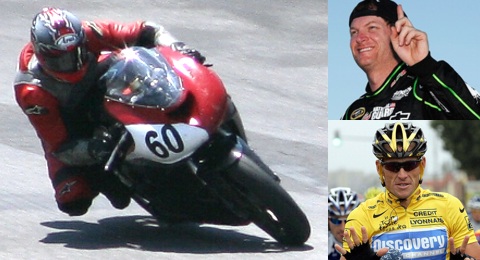Speed is universal. It is the variety of the vehicle that becomes a variable. It can be anything. The standard issue human body put to the test on the road of a marathon or a swimming pool or can be seen as a basis for muscle and blood endurance. Once you add a machine to the equation, the skills of handling the machine become another variable to consider.
In a very short period of time, we have been to one location to witness a range of machines and the people pushing their limits within. At Virginia International Raceway, variety is almost a constant. The terrain, the turns, the trees and the technology all come together in form and function. We have seen stock cars, prototypes, open-wheel and production based cars being raced here. Most recently, it was side by side racing with two less wheels.
Motorcycle racing is different. It is fast and fun to watch. The acceleration and the angles are multiplied by the human element which is plainly visible through every motion. The body is enclosed in a car. Surrounded by a roll cage and steel, the driver is mostly hidden from view. The motorcycle offers only a helmet and some bits of leather.
The racing is as tight, close and fast as the cars. The human element, plainly visible, on the throttle and on the brake, adds an element of drama. This particular weekend, as bikes and riders looked for speed along the scenic views of VIR, there was drama seeping in from all around the world of racing.
In NASCAR, Dale Earnhardt, Jr. won a race. It is easy to to sum it up in one line. He won. It is the drama leading to this particular race that creates the story. Every race has a winner. The story here is challenge, a historic father, expectation, team changes and a long run of being so close and not quite making it.
In France, Audi not only won the pole but survived the 24 Hours of Le Mans with a hybrid design. Audi teams crossed the line in the first four slots with two hybrids in the lead. Survival, skill, technology and drama.
Now, take away the engine and keep the human element. Enter this past weekend the drama of another kind of racing. Two wheels with power provided only from muscle and blood. The Tour De Suisse ended Sunday and international cycling teams are looking to their big event. The Tour de France is on the horizon.
Sunday, as a NASCAR icon is lifted up to victory lane following a long struggle to get there, as hybrid technology overcomes hurdles to win for an automotive icon, another icon of racing is faced, yet again, with an opposite force.
Lance Armstrong, seven time Tour de France winner, is faced yet again with charges of using enhancements to win. This time, it is the United States Anti-Doping Agency. No other athlete as been tested as Armstrong has. During his TDF years he was tested repeatedly. During the off-season, he was tested. At the beginning and end of each Tour he was tested. After each stage he faced testing. Over 500 tests and there was nothing. The French have reviewed. United States sports authorities have reviewed. The cycling authorities have reviewed. Nothing.
Most recently, a federal investigation was dropped due to lack of evidence. With a “lack of evidence” at that level where does the USADA come up with something that they can claim as evidence?
Racing, by nature, is controversy. Drama fueled by competition. Competition fueled by chasing victory within the assigned parameters of established guidelines to maintain the essence of fair play. Round again to controversy when those guidelines are challenged.
At what point is the drama and controversy left behind on one chapter so we can move on to the next? Does a victory from Dale Jr. end the controversy on his ability to win? Will hybrid technology advance with race wins? Does passing 500 drug tests close the book and allow Lance Armstrong to put that away?
We started at Virginia International Raceway and now we find ourselves at the Tour de France. Confused…?
As are we.
